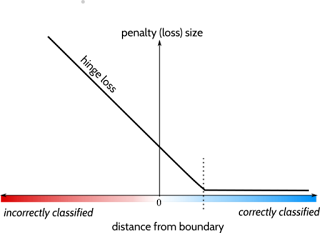Loss Function-Hinge Loss

In machine learning,for training classifiers there one loss function which is called hinge loss. I've read numerous articles and blog posts about the Hinge Loss and how it works. However, I feel that the most of them are rather ambiguous and do not provide a clear explanation of what the function performs and what it is. Instead, most of the time, an illegible graph is displayed, leaving the reader perplexed. I intend to simplify the function in this essay, both aesthetically and mathematically, to assist you obtain a firm understanding of the cost function. But first, let's brush up on your knowledge of cost functions! The hinge loss is a loss function that is commonly used for training classifiers such as the SVM. Here's a great illustration of what it looks like. The x-axis shows any one instance's distance from the boundary, while the y-axis reflects the size of the loss, or penalty, that the function will experience based on its distance.

